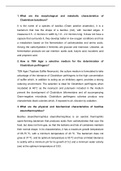1. What are the morphological and metabolic characteristics of
Clostridium botulinum?
It is the name of a species of bacillus (Gram positive anaerobic), it is a
bacterium that has the shape of a bacillus (rod), with rounded edges. It
measures 0.5 - 2 microns in width by 1.6 - 2.2 microns long. It does not have a
capsule that surrounds it, they develop better in low oxygen conditions and has
a metabolism based on the fermentation of carbohydrates and amino acids.
Among the carbohydrates it ferments are glucose and mannose. Likewise, as
fermentation products we can mention: acetic acid, butyric acid, isovaleric acid
and propionic acid.
2. How is TSN Agar a selective medium for the determination of
Clostridium perfringens?
TSN Agar (Tryptose Sulfite Neomycin), the culture medium is formulated to take
advantage of the tolerance of Clostridium perfringens to the high concentration
of sulfite which, in addition to acting as an inhibitory agent, provides a strong
reducing environment. The selection is ideal for Clostridium perfringens when
incubated at 46°C as the neomycin and polymyxin included in the medium
prevent the development of Clostridium bifermentans and all accompanying
Gram-negative microbiota. Clostridium perfringens colonies produce very
characteristic black colonies which, if exposed to air, discolor by oxidation.
3. What are the physical and biochemical characteristics of bacillus
stearothermophilus?
Bacillus stearothermophilus stearothermophilus is an aerobic thermophilic
spore-forming bacterium that produces acids from carbohydrates that sour the
food, but does not form gas, so that the bottoms and lids of containers maintain
their normal shape. In its characteristics, it has a maximum growth temperature
of 65-75 ºC, with a minimum temperature of 40 ºC. The bacterium does not
grow at 37 ºC, and its optimum temperature is 55 ºC and has a limited tolerance
to acidity with a minimum pH for its growth of 5.2 and a minimum water activity
(aw) at the optimum temperature of 0.93.
, 4. How does Bacillus stearothermophilus contamination occur in canned
foods?
In canned foods the incidence of spores is of great interest, they enter the
cannery through the soil, in raw foods and in ingredients, e.g., spices, sugar,
starch and flour. The presence of Bacillus stearothermophilus spores in some
commercially sterile, low-acid foods from a given batch.
5. What are the kinetic parameters of thermal inactivation of
microorganisms in canned foods?
A critical aspect in the calculation of thermal processes is the need to know the
parameters that quantify the influence of lethal temperatures on the inactivation
of microbial populations. The impact of lethal temperatures on microbial
populations requires reference to the Decimal Reduction Time (D-value) and
the Thermal Destruction Time (TDT or F-value), in addition to the concept of the
Thermal Resistance Constant Z value numerically equals the number of
degrees (in ºF or ºC) required to change in one logarithmic cycle, or by a factor
of 10, the value of the decimal reduction time (D-value).
6. How to identify thermophilic flat acid spore-forming microorganisms
such as Bacillus coagulans?
For their identification, the method for sugar analysis is used, which allows to
have samples of solid or liquid sugar. If the liquid product is analyzed, the
amount added to the initial dilution is adjusted to contain an equivalent of 20 g
of dry sugar. After heating to 100°C, 2 ml of the heated sugar solution is added
to each of five Petri dishes before adding Man Rogosa Sharpe Agar (MRS). In
the procedure the plates are incubated at 55°C for 35 to 48 hours. Typical
colonies are round, 1-5 mm in diameter, with an opaque spot in the center,
yellow halo.
7. What are the colonies of clostridium histolycum on Zeissler agar, blood
agar and what are their biochemical and morphological characteristics?
This bacterium is anaerobic C. histolyticum can be seeded on Zeissler agar
plate and appear as dew-like colonies of rough or smooth morphology,
surrounded by a zone of weak hemolysis. On blood agar, the colonies appear




